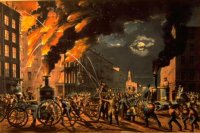Currier & Ives - America's Printmakers - Part I
January 13, 1840 the luxury steamboat "Lexington" burned and sank in Long Island Sound, killing 123 people. When the news reached editor Ben Day's office at the popular daily newspaper, "New York Sun" an inspiration came to him that would revolutionize the newspaper industry and launch a young "lithographer" (print-maker) into one of the most influential careers in American history. "Why should newspapers consist of only words?" Ben said to himself. "Would not a picture of the disaster sell papers?"
Mr. Day recalled that five years earlier, 23 year old Nathaniel Currier made a reputation for himself by issuing the highly successful graphic print "The Ruins of the Merchants' Exchange N.Y." four days following the destructive Wall Street fire of  December 16 & 17, 1835. Currier was commissioned for the job.
December 16 & 17, 1835. Currier was commissioned for the job.
In what was amazing speed at the time, three days, Nathaniel Currier produced for the Sun a violently realistic small print called "Awful Conflagration of the Steam Boat LEXINGTON In Long Island Sound on Monday Eve.g Jan 13th 1840 by which melancholy occurrence 123 Persons Perished." (Currier was fond of long titles in his early years.) The venture was so successful presses run night and day to accommodate public demand. Day's seven column publication of "The Extra Sun," complete with picture would sell out five times and be distributed nationally receiving glowing reviews. Other newspapers would follow Day's lead. The era of picture papers had begun.
Currier was not a man to ignore endeavors that proved successful. For years to come, not a blaze, ship-wreck, or cataclysm would occur without finding its way to one of his lithograph printing stones. Great artists like George H. Durrie, Arthur Fitzwilliam Tait, James Buttersworth, Thomas Nast, and Louis Maurer were employed; each executing prints in their artistic element. For instance, Durrie scribed out New England Farm scenes while Buttersworth focused on clipper ship prints. In 1852, Currier hired James Merrit Ives to keep his books. Ives proved so talented as an artist and businessman he was made partner in the firm within five years. The firm would produce over 6000 prints in the next 70 years - most selling well. Russel Crouse describes the partners in his 1930 book entitled "Mr. Currier and Mr. Ives," as "sharing a keen and seldom-failing nose for news. They were the tabloid publishers of their day, seeking to catch the eye of the passing crowd with something strikingly graphic."
Currier and Ives recognized men's attraction toward danger and sport. They depicted scenes of whaling, bear hunts, baseball games, ship battles, and pioneers conquering the West. Horses in their numerous trotting prints would become models for almost all horse weathervanes. The partners also recognized 19th American women's fondness for sentiment.
Their bustling company stamped out "God Bless Our Home" prints, and scenes depicting flowers, courtship, children, pets, buggy rides, and maple sugaring. For years, it was uncommon to enter an American home without at least one Currier and Ives hanging prominently. Together, these prints constitute the most significant and influential pictorial record of 19th century America. Naturally, they are highly sought after as antiques today. Next week I'll provide you with some tips on collecting Currier & Ives prints.
